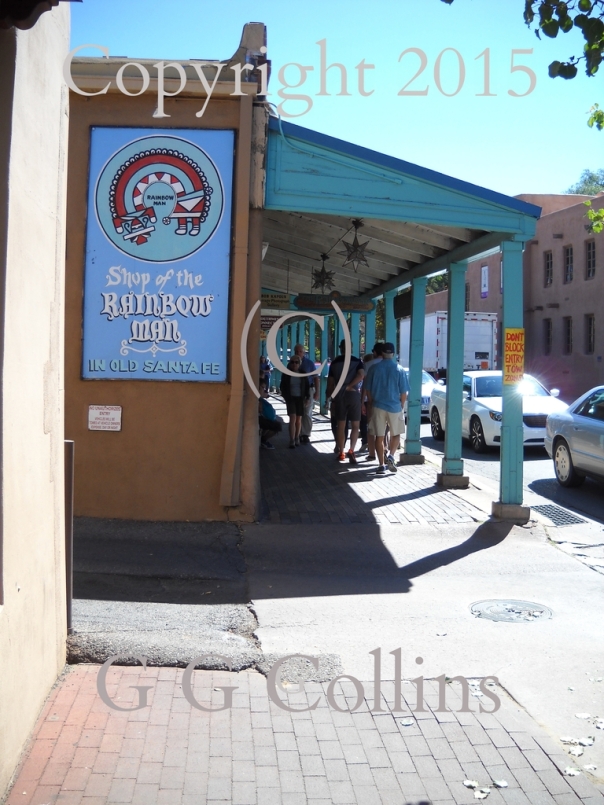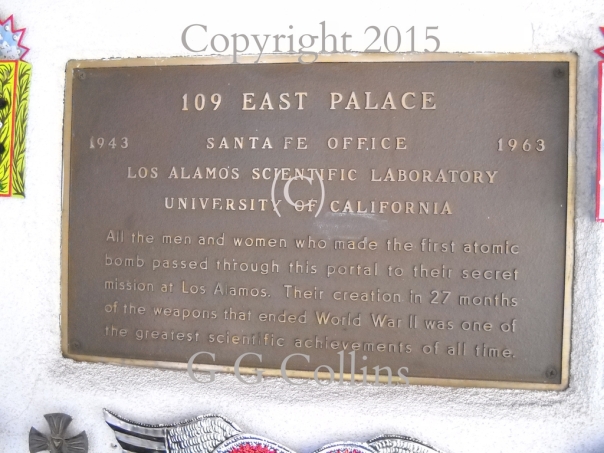Blog Archives
The Manhattan Project: 78th Anniversary of the Atomic Bomb
The Building That Changed the World
By G G Collins Copyright 2015/Updated 2023

Rainbow Man shop
Former office of The Manhattan Project
On Palace Avenue just steps from the famous Santa Fe Plaza is a small building that changed the world. It was the headquarters for The Manhattan Project, the top secret mission to build the first atomic bomb and end WWII. Everyone, scientist and secretary alike, passed through this building. They came in the front door and left by the back door where they were secreted off to the Atomic City. No one left by the back door unless Dorothy McKibbin gave them a pass to “The Hill.”
McKibbin was looking for a job in March of 1943. She was offered employment at the First National Bank for $120 per month. Working at a bank wasn’t really what she wanted to do, but income was income. Then she met Joe Stevenson in an awkward conversation in the middle of the Plaza. He told her there was a secretarial position open that would pay $150 per month. But Stevenson was mysterious about what the job would entail.
She did accept the job and became the gatekeeper to one of the biggest discoveries of the last century. McKibbin kept that job until 1963 when she retired. She would remain a loyal friend to Robert Oppenheimer until his death in 1967.
The historic site, originally constructed in the 1600s as a Spanish hacienda, is now home to Rainbow Man. The shop is filled with Native American hand-made items, blankets, photos and folk art in vivid colors. The courtyard is beautiful rain or shine. Flowers brighten the entrance in vibrant hues. The old wagon only becomes more silvered with each passing year.
At the back of the courtyard, under the portal and behind the chile ristras is a plaque dedicated to those who split the first atom. Shoppers visit the store to take home a little bit of Santa Fe. Historians stop by for the history and wonder what it must have been like in the 1940s when The Manhattan Project was in full swing.

Commemorative Plaque to those who worked on The Manhattan Project
July 16 was the 78th anniversary of the Trinity Test at White Sands, New Mexico.
For more information, try these books:109 East Palace by Jennet Conant, The Manhattan Project edited by Cynthia C. Kelly, The Making of the Atomic Bomb by Richard Rhodes.

Atomic Medium, takes place in Santa Fe during 2015 and 1945. It is the third installment in the Rachel Blackstone Paranormal Mystery Series. Get it at Amazon: http://amzn.to/1SWkjde







Birth of the Atomic Bomb
Jul 27
Posted by G G Collins
I Am Become Death, the Destroyer of Worlds – Bhagavad Gita
By GG Collins Copyright 2023
“The beginning of the atomic age began with a pinprick of light so bright it lit up the desert with the power of several midday suns … ” – Atomic Medium
https://tinyurl.com/5n74s59r
When I began writing Atomic Medium I thought the world had forgotten this era. But thanks to a movie called Oppenheimer a new generation is learning about the men and women who developed the bomb. Not with computers and smart phones but with a little thing called a slide rule and human calculators.
By Jack W. Aeby, July 16, 1945, Civilian worker at Los Alamos laboratory, working under the aegis of the Manhattan Project. – This image comes from the Google-hosted LIFE Photo Archive where it is available under the filename 96ad5a9a5c94664e.This tag does not indicate the copyright status of the attached work. A normal copyright tag is still required. See the copyright section in the template documentation for more information., Public Domain, https://commons.wikimedia.org/w/index.php?curid=140895
I was lucky to have access to photos from the Atomic City of Los Alamos including pictures of the houses where the scientists lived and the mess hall where they ate. I poured over maps of the compound and read books describing the times. Many of my sources are listed below and a full list can be obtained in the bibliography at the end of Atomic Medium.
My characters, reporter Rachel Blackstone and her friend Chloe Valdez, went back in time to 1945 New Mexico. It was here they experienced the first treacherous step into a future of unimaginable weapons.
“They dropped to the ground and held each other. They trembled with terror. Rachel wondered if their hair would burn off or if they were on the verge of incineration.” – Atomic Medium
“Calling it a weapon of mass destruction sounded like an understatement; a news bite, trivial. This was obliteration; one second you were there and the next you were vapor being inhaled by hell’s meteor.” – Atomic Medium
By Trinity_crater.jpg: Federal government of the United Statesderivative work: Bomazi (talk) – Trinity_crater.jpg, Public Domain, https://commons.wikimedia.org/w/index.php?curid=12817993
We talk about nuclear weapons today like they have always been here. Each year scientists move the Doomsday Clock a bit closer to midnight. In January 2023 it was moved to 90 seconds before midnight. That’s how close we are to apocalypse.
* * *
Atomic Medium will be priced at .99 cents on July 30, 2023. https://tinyurl.com/5n74s59r
For additional blog posts on this subject: Atomic Bomb Test Successful but Deadly https://tinyurl.com/mu6mdz3v and The Building That Changed the World https://tinyurl.com/22bpr67t
For more reading: Bibliography of Atomic Medium
109 East Palace by Jennet Conant, Simon & Schuster Paperbacks, 2005.
The Manhattan Project, edited by Cynthia C. Kelly, Black Dog & Leventhal Publishers, Inc., 2007.
The Making of the Atomic Bomb by Richard Rhodes, Simon & Schuster Paperbacks, 1986 by Rhodes & Rhodes.
A Few Good Women by Evelyn M. Monahan & Rosemary Neidel-Greenlee, Alfred A Knopf, 2010.
The Streets of Santa Fe by Josh Gonze, 2012.
A Spy’s Guide to Santa Fe and Albuquerque by E. B. Held, University of New Mexico Press, 2011.
Manhattan Project Suitcase, Manhattan Days Script, Los Alamos Historical Society, http://www.losalamoshistory.org
Los Alamos National Laboratory/Science Photo Library at www.sciencephoto.com/media
Atomic Heritage Foundation, Profiles at www.atomicheritage.org/bios
Los Alamos National Laboratory, LANL History in Images at www.lanl.gov
Manhattan Project Heritage Preservation Association, Inc., The Otowi Bridge at http://www.mphpa.org
“Manhattan Project spies who met in Santa Fe changed the balance of the world” by Tom Sharpe, The Santa Fe New Mexican, September 27, 2000.
“The Difficulties of Nuclear Containment” by Sam Roberts, The New York Times, September 29, 2014.
Share this:
Posted in About, Atomic Medium, commentary, Excerpt, Historical Fiction, History, Museums, New Mexico, Santa Fe
Comments Off on Birth of the Atomic Bomb
Tags: Atomic Bomb, Atomic City, Atomic Medium, G G Collins, Los Alamos, Manhattan Project, New Mexico, Oppenheimer, Santa Fe, Trinity Test